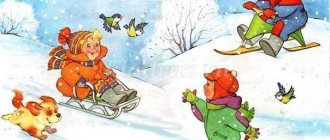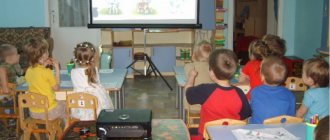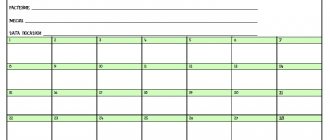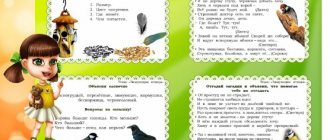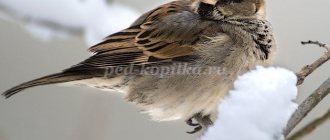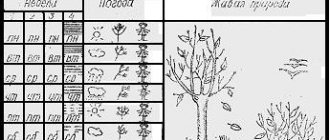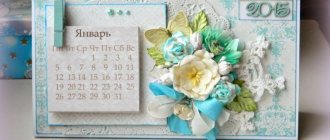Organization and content of observations in preschool educational institutions
Definition 1
Pedagogical observation in kindergarten is one of the methods used by preschool teachers and specialists to collect the necessary information about students.
The purpose of pedagogical observation in a preschool educational institution is to collect information on sensory, communicative, intellectual, creative, etc. development of preschool children.
In the process of pedagogical observation, preschool teachers and specialists not only collect the necessary information, but also note the general dynamics of children’s development. This is necessary in order to timely adjust the educational process and select the most optimal methods and means of raising and teaching preschool children.
Are you an expert in this subject area? We invite you to become the author of the Directory Working Conditions
The importance of pedagogical observation in preschool educational institutions is invaluable, since this method allows the study to cover a sufficiently large number of pupils, conduct research at any convenient time, and helps the researcher “see” the child in his natural environment. During the observation process, the teacher notes the peculiarities of interaction between students, determines the presence of microgroups based on interests, identifies the inclinations and creative needs of children, and much more.
The success of pedagogical observation in a preschool educational institution largely depends on the quality of its organization of the teacher, as well as on his professionalism and ability to organize this type of research. The conclusions obtained and their accuracy depend on the adequacy of the assessment of the child’s behavior and level of development. If the teacher “overlays” his personal attitude towards the child onto the data obtained, then the information obtained during the study will not be reliable and accurate.
Note 1
Thus, pedagogical observation in preschool educational institutions is of great importance for collecting information about the level of development of preschool children, the characteristics of their interaction with each other and identifying their leading creative needs and inclinations.
Finished works on a similar topic
Course work Pedagogical observation in kindergarten 410 ₽ Abstract Pedagogical observation in kindergarten 260 ₽ Test work Pedagogical observation in kindergarten 210 ₽
Receive completed work or specialist advice on your educational project Find out the cost
For little fashionistas and fashionistas
I found the website of our Russian manufacturer - the trademark “Lacy wear”. I have already looked at good things for my son, a good store with reasonable prices. Here you can buy everything from socks and T-shirts to winter jackets.
An excellent section of children's knitwear - hats, underwear, pajamas. St. Nicholas Day and New Year are just around the corner, so it’s time to start looking for gifts under your pillow and Christmas tree!
Yes, have you ever ordered goods from Ali Express? Good reviews about this store, high quality products, reasonable prices. Here you will find clothes for newborns and teenagers. Delivery is carried out in a short time and seems to be free. If anyone has ordered from these sites, please tell us!
Let's help each other and tell us where to cheaply dress our children? Where do you stock up on clothes for yourself and your children, and how do you get out? Winter shoes are especially expensive now, maybe someone has found inexpensive but decent shoes?
Although we have heard since childhood that we should not judge a person by his appearance, at the same time we were taught to be neat and tidy. What can you do, but clothes always work on a person’s image. When describing a person as we see him, we definitely pay attention to the “shell” - a coat, a hat... But it’s time to get down to business.
Structure of pedagogical observation
The organization of pedagogical supervision of a preschool educational institution assumes compliance with the following structure:
- Setting the purpose of observation.
Pedagogical observation must have a clear goal aimed at studying a specific area of children's activity or aspects of the child's personal development. Based on the set goal, the teacher formulates tasks, the gradual solution of which will “lead” to achieving the goal.
- Choosing a situation in which the process of pedagogical observation will take place.
The choice of situation depends on the intended purpose of observation. If the teacher is studying the interaction between pupils, then suitable situations for observation include children playing together, a walk in the area, free activity time, etc. If the purpose of observation is the level of development of the child, then it is more appropriate to observe him in the process of GCD. However, regardless of the goal, in order to obtain the most accurate and complete picture, it is necessary to carry out pedagogical observation of children in all types of activities and record the facts obtained.
- Drawing up a Pedagogical Observation Program.
In order for the information collected during the process of pedagogical observation to be accurate and complete, the research must be carried out systematically and systematically. For this purpose, the teacher develops a Program that includes goals, objectives, observation tools, methods of recording and processing data. The choice of method for recording and subsequent processing of the received information and data depends on the goal and the nature of pedagogical observation. In addition, the Program indicates the time for conducting pedagogical research.
- Direct implementation of pedagogical observation.
During this period, the teacher observes the students and records the information received.
- Processing and interpretation of the results of pedagogical observation.
All obtained results are processed and presented in visual form (diagrams, tables, graphs, etc.). Based on visual data, the teacher formulates conclusions and records them in an observation card (diary). The data obtained is compared with data that was obtained earlier, and appropriate conclusions are also drawn, on the basis of which the teacher can see the dynamics of the child’s development. In the event that the dynamics are insignificant or completely absent, then the educator is faced with the question of the effectiveness of the educational process he organizes.
Observation as the leading method for preschoolers to understand nature
Bibliographic description:
Kosheleva, O. A. Observation as the leading method of cognition of nature by preschoolers / O. A. Kosheleva. — Text: direct // Questions of preschool pedagogy. — 2022. — No. 1 (7). — P. 48-53. — URL: https://moluch.ru/th/1/archive/49/1544/ (access date: 01/19/2022).
Observation is a purposeful, systematic perception of objects and phenomena of the surrounding world. This is a complex cognitive activity that involves perception, thinking and speech, and requires sustained attention.
In the process of short-term observations, organized to form knowledge about the properties and qualities of an object and phenomenon, children learn to distinguish shape, color, size, spatial arrangement of parts, the nature of the surface, and when familiarizing themselves with animals, the nature of movement, sounds made, etc.
To accumulate knowledge about the growth and development of plants and animals, about seasonal changes in nature, a more complex series of observations is used - long-term observation; At the same time, children compare the observed state of the object with what was before.
Observation can also be organized in order to determine the condition of an object by some individual signs (for example, by the color of the soil in flower pots to determine the need for watering, by the behavior of fish in an aquarium - the need for a partial change of water) or to restore the picture of the whole (by the traces on in the snow, determine who has passed or passed by the color of the berries - whether they are ripe or not). This type of observation presupposes that children have some knowledge, the ability to analyze a phenomenon, compare individual data, and make simple conclusions.
The last two types of observation, due to their complexity, are used in work with children of middle and senior preschool age. During these observations, intelligence and observation skills develop, and the processes of analysis, comparison, and inference are improved. Observations are organized by the teacher when introducing children to plants and animals, the weather, the work of adults in nature, they are carried out during classes and excursions, on walks, in a corner of nature, etc. In some cases, the teacher organizes all the children, in others - the observation is carried out with in a small group or with one child. This depends on the content of the observation and the tasks that the teacher sets for himself. But in all cases, it is necessary that the observation takes place during any mental activity of children, forces them to think, look for answers to the questions posed, develop curiosity, cultivate interest and respect for nature.
Preparing for observation. The teacher's preparation for observation begins with the selection of an object. The plant or animal chosen for observation must be in good condition. If the observation is carried out indoors (in a corner of nature, in a lesson), you should think about its organization: the object should be well lit (better when the light falls from the side), located in such a way that it is easy to approach. Children are placed closer to the object of observation, so that everyone can clearly see it, and if necessary, they can act with the object of observation (feed, pet, play).
To observe on the site or in the immediate natural environment, it is necessary to choose the most convenient place and arrange the children so that it is convenient for everyone to observe.
If an animal is observed, it is necessary to create an environment in which the animal behaves freely and naturally. For example, when watching a rabbit, a fairly spacious pen is built for it, around which children are placed on chairs. A mat or rug should be laid on a parquet floor (or covered with linoleum), otherwise the animal will slide when moving on a smooth floor.
Supervision guidance.
At the beginning of observation, especially if it is carried out for the first time, you should not rush to pose a question or task to the children. It is necessary that they independently look at the object for 1–2 minutes, satisfy their naturally arising curiosity, and form a first impression of what they observe. In the process of guiding observations, the teacher uses a variety of techniques (taking into account the age of the children): questions, riddles, examination of the subject, comparison, play and work activities. He explains, tells, helping the children understand what they see. In order to arouse interest, an emotional attitude to observation, and ensure an aesthetic perception of objects, he uses poetry and small forms of folklore when working with children, and with older children, at the end of the lesson, he also reads excerpts from works of art.
Observation must proceed in a certain sequence. When guiding the observation of animals, the teacher directs attention primarily to their behavior: “What is he doing? How does he move? What does it eat? How?" And only in connection with some action are the external signs of the animal considered: “What is the body covered with? Are your legs long or short? What kind of eyes (shape, color)?
Examination of a plant begins with identifying and highlighting the brightest, most striking feature - whether it is a flower or brightly colored leaves, and sometimes an unusual stem. After this, the main features of the external structure of the plant are determined: they consider in order the size, shape of the stem (or trunk), leaves, again the flower, etc. This sequence is necessary because the attention of preschoolers is not yet stable enough, and is largely involuntary. However, at the end it is necessary to organize the ideas formed during the observation. Using various techniques for presenting a task, the teacher accustoms children to a consistent story about what is being observed: the size, shape of the object, cover, color, peripheral parts and their features, and when observing an animal, its behavior. This order is necessary especially when children get acquainted with a new object.
During repeated observations, when the task is to establish the state of a plant or animal (for example, looking at a tree with colorful leaves in the fall or blooming in the spring, observing the behavior of sparrows bathing in a spring puddle), you can start with solving the main problem. In all cases, the teacher, when organizing observation, must maintain consistency in the transition from one specific observation task to another, from facts to connections, from the accumulation of ideas to their comparison, and then to conclusions. Each observation solves a small, specific task of introducing children to nature. Therefore, when conducting an observation, the teacher must always establish possible connections between the present observation and those carried out earlier, and take into account subsequent work.
When organizing a long-term observation of natural objects, the teacher divides it in advance into a series of episodic observations, which are carried out when changes, say, in the development of an animal, become quite pronounced. The teacher invites the children to examine it, note the signs, compare its condition with what was observed before, and identify new signs indicating a change. Sometimes children immediately notice what has changed in animals, but even in this case, the teacher turns to comparison so that the noted changes are clear to everyone. In the final observation, the entire picture of development observed by the children should be restored. An observation diary will help with this (it can be different: in the form of drawings, a herbarium, in older groups and as a schematic reflection of changes.
Observation using handouts.
The organization of such observation is more complex than observation of a single object. Here, the teacher is required to be able to distribute attention, organize the actions of all children, and they must strictly follow the teacher’s instructions, hear and listen to others, compare and contrast the observations of others with their own. This method of organizing observation is of great developmental importance: all children have the opportunity to practice a variety of investigative actions, improve their learning skills, and they develop more accurate ideas. During the observation period, the teacher asks the children questions and organizes an examination of objects. The received ideas are compared, and the teacher leads the children to a conclusion.
Plants and their parts can be used as handouts: leaves, fruits and seeds, branches, vegetables and fruits. Each child participating in the observation receives a set of material in his hands (this is the teacher’s sign). the use of handouts during the observation process ensures high activity of all children.
Junior groups. The first observations are carried out with a small number of children. The main task of the educator is to develop in them the basic skills necessary for observation: to focus attention on the observed object for a more or less long time, to answer questions posed, to highlight striking signs (2-3). Babies are attracted to bright and moving things, so the first observations with children of this age are best done with animals. Their movements, feeding, and sounds arouse involuntary interest in young children.
At first acquaintance, children's attention is focused on directly examining the animal. Therefore, while guiding the observation, the teacher uses various techniques to encourage the animal to move (for example, placing food at a certain distance), attracts children to feeding, draws their attention to how the animal eats (crunches, holds food with its paws), calls actions in words. Children repeat the words after the teacher. During subsequent observations, the teacher raises a question about one or another action of the animal, encouraging the children to use the words they know. For example, a goldfinch is pecking grains, and the teacher asks: “What is the bird doing? What is she biting about? etc. It is important that the question coincides with the action of the animal. Thus, children gradually learn to accept the specific task of observation contained in the question.
Observations made with young children are short-term. However, in order to keep the children’s attention, the teacher gives some of them instructions: pour grain into the feeder or give a carrot, pour water into the drinking bowl. To help highlight the characteristics of the animal, he suggests petting it (if possible). Gaming techniques are also used: imitation of movements, sounds, establishing unique contacts: “The bird sings a song for children”; “The fish swims to Kolya, and now to Masha.”
During collective repeated observations, in order to arouse children's attention and interest, you can use unique surprise moments: there is a knock on the door, a kitten comes in; or: they bring in a basket covered with cloth, take it off - there is a rabbit in the basket. At the end of the observation, you can read poetry or sing a song. It is inappropriate to require children to talk about what they observe.
In the process of observing the weather or other objects of inanimate nature, examining plants, the teacher connects these observations with elementary work activities or play (they examine the leaves of indoor plants and wipe them, examine the bulb before planting, examine the humidity and flowability of the sand while playing with it). When organizing observations with children, it is advisable to more often use a variety of observational actions: expose your palm to the sun and feel the warmth, smell a flower, etc.
Middle group. Observation is most often used to familiarize children with new objects and to expand their understanding of familiar objects and phenomena. At the same time, the teacher organizes long-term observations with the children of the growth and development of plants and the striking seasonal changes in the life of nature. Initially, these observations are carried out on individual objects (for example, the coloring of the leaves of one of the trees in the fall, the growth of beans, peas planted in a corner of nature, etc.) Then long-term observation can be carried out on a set of objects. For example, in a park or garden in the spring, observations are simultaneously made of the blossoming of leaves, the flowering of herbs, the weather, and birds.
In the course of observing changes in nature, children in the middle group learn to identify characteristic features in observed objects: size, color, shape, parts, proportions, surface character, number. As a result, observation becomes differentiated, and children’s ideas, formed on the basis of observation, become more specific and accurate. The teacher teaches children to follow the plan that he proposes in the form of a sequential stop of questions and tasks.
The purpose of observation is often associated with work (“Let’s look at a bird and learn how to care for it - it will live in our corner of nature”) or visual activity. Most often, cognitive purposes are used, for example, going to the garden and seeing which trees have bloomed, looking at them in order to learn to recognize them, etc.
Sometimes the teacher offers a riddle, the answer to which the children find in the process of examining the object. Or the riddle itself is “objective”: for example, think about what animal the food was prepared for, then check the correctness of the assumption during observation.
Children in the middle group can participate in creating the environment necessary for observation (prepare food, make a pen for an animal), which increases interest in observation.
As in the younger group, a variety of survey activities, game techniques, and work assignments are used during the observation process. Some of these activities may be exploratory in nature. In observations with children in the middle group, the teacher begins to use comparison. Two objects are compared (the children are already familiar with one of them). For comparison, the teacher sequentially identifies the signs.
In the middle group, children begin to observe independently. They should be encouraged, helped to understand the observed phenomenon, sometimes advised to use this or that technique, also attract the attention of other children to the observation, and encourage them to tell their peers about the results of their observation.
Senior group. In the process of observations, children in the older group are introduced to the characteristic and essential features of objects. Long-term observations of the growth and development of plants and animals and seasonal changes in nature are also carried out. The teacher continues to teach children to accept the task of observation, use methods known to them, follow the plan, and independently draw simple conclusions and conclusions. In observed objects and phenomena, children learn to identify essential features that are significant for a particular activity or are common features of an entire group of objects, to establish connections and relationships between objects and their surroundings. By observing the growth and development of plants and animals, and seasonal changes, children develop the ability to see a natural sequence of phases, stages or states.
In guiding observations, the teacher uses direct formulation of tasks, primarily cognitive ones. The questions with which he directs the children’s perception are exploratory in nature, requiring to establish the cause and make a comparison.
At this age, children identify the main features of objects using vision. They resort to various investigative actions only in cases of testing judgment or in cases of difficulty. The methods of comparison used in observation are becoming more diverse: the observed object is compared with another, depicted in a picture or in a representation. Not only individual objects are compared, but also natural phenomena (for example, a park in spring and winter). Along with establishing differences, the teacher directs children's attention to features common to several objects, especially those that reflect their essential aspects. For example, while observing different insects, children discover that each one has 6 legs. Having given the task to compare what is being observed, the teacher gives the children independence in determining the signs by which the comparison is being made, providing assistance only in cases of difficulty. Children's verbal report of the observation results should be as independent as possible. They reflect the results of observation in drawings and crafts.
When working with children of the sixth year of life, long-term observations become more differentiated: the teacher draws attention to less striking changes in nature. For example, watching the growth of peas, children note the appearance of a sprout, then leaves, an increase in their number, the appearance of whiskers, buds, and flowers. They reflect the results of these observations in nature calendars and observation diaries.
Preparatory group for school. The peculiarity of supervising observations in this group is to create conditions for children to demonstrate greater independence. The main content of observations is the establishment of various connections and relationships between natural phenomena. Children themselves identify features to compare observed objects. Their attention should be directed to identifying similar features that are common to a whole group of objects. When making comparisons, children also use those ideas that are available in their experience (they compare from memory).
The teacher gives some tasks for long-term observations in advance, then occasionally reminds them of them. During short-term observations, he uses task questions (for example: “How is the new bird different from the one that lived with us before? Are the trees and shrubs of our area the same in color?”, etc.). Additional questions are asked only when children find it difficult to answer something. For the same reason, survey actions are also used.
In their observations, children of the preparatory group can use simple devices, and sometimes instruments - a thermometer, a weather vane, magnifying glasses, slats, etc.
Excursions.
During the excursion, the child can observe natural phenomena and seasonal changes in a natural setting. The advantages of excursions and activities are that here children have the opportunity to see plants and animals in their habitat. The excursion helps to form in children primary worldview ideas about the relationships that exist in nature, a materialistic worldview. On excursions, children develop their powers of observation and interest in studying nature.
The main part of the excursion is collective observation. Here the main program tasks of the lesson are solved. The teacher helps children notice and understand the characteristic signs of objects and phenomena. This is achieved in various ways. The teacher supplements the observations with his story and explanation.
The main attention in observation is paid to questions, questions - tasks that force children to examine an object, compare, find differences and similarities, and establish connections between natural phenomena. It is useful in the process of observing phenomena to use works of children's fiction, poems, and riddles. Turning to poetry should be natural and unobtrusive. The combination of various techniques and the proportion of each can vary depending on the purpose and content of the excursion. At the end of the main part, children must be given the opportunity to satisfy their curiosity in individual independent observations and collection of natural history material. However, when giving the task to collect material, you should strictly limit its quantity in order to focus the children’s attention only on certain plants or animals, and in addition, solve the problem of instilling a caring attitude towards nature.
When children work independently, the teacher should not remain a passive observer. Sometimes you need to show how to dig up a plant, cut a branch, etc. However, you cannot do all the work for the children. The collected material is sorted, placed into folders and baskets, and some of it is used for games and exercises.
In games, children consolidate knowledge about the characteristic features of objects, express their quality in words, and remember the names of plants and their parts. The following games are advisable: “Recognize by the smell”, “Guess by the description”, “Branch, branch, where is your baby?”, “One, two, three - run to the ash (linden) tree!” and etc.
Observations in classes and excursions are carried out in close connection with other forms of work in everyday life.
Walks.
Walks are widely used to introduce children to nature. Here the teacher can acquaint the children with those natural phenomena, ideas about which have been developing for a long time. Children are introduced to the melting of snow, the swelling of buds, the appearance of grass, etc. Here you can organize a variety of games with natural materials - sand, clay, water, ice, leaves, etc.; Preschoolers accumulate sensory experience; they see natural phenomena in natural conditions in all connections and relationships. On walks, children experience the pleasure of communicating with nature.
Everyday observations of natural phenomena should not be random; they must be thought out in advance. In this case, various forms of organizing children should be used (frontal, group, individual). Frontal organization of observations on walks is used to familiarize children with the bright seasonal changes and the difficulty of adults. Observations can also take place with small groups of children (examination of a flowering plant, emerging shoots, insects, etc.). Individual work is also carried out during the walk.
During a walk, you can do a lot of work in the flower garden and vegetable garden. Children water the plants, feed them, loosen the soil. This work is planned for the morning and evening.
To work in the vegetable garden and flower garden, children are organized depending on the purpose. They can perform some tasks as a whole group (planting, sowing, harvesting), while others (preparing the land, watering plants, loosening, cutting dry leaves, collecting seeds, etc.) are best done with a subgroup of children. In older groups, it is possible to organize on-site duty in the spring and summer.
Children of the senior and preparatory school groups reflect on observations on walks in the nature calendar, where they sketch bright seasonal changes in inanimate nature, in the life of animals, plants, and reflect the work of people.
Starting with the second youngest, targeted walks are carried out (with going outside the kindergarten site - to a pond, to a meadow, to a pasture, etc.). On these walks, children are introduced to colorful natural phenomena (rook nesting, ice drift).
Observations in a corner of nature.
Work to familiarize preschoolers with nature in kindergarten is carried out daily. The form of organization of children varies (depending on age and content of work). Occasionally, all children are involved in work and observations, but more often work and observations are carried out in such forms as assignments and duties. Children of the younger group are involved in carrying out certain work assignments. Permanent duty of 2-3 people is introduced from the senior group.
Nature is the child’s first aesthetic educator. By observing nature, the child will learn to see, understand and appreciate its beauty.
Any observation is a cognitive activity that requires attention, concentration, and mental activity from children, so it does not last long. Pedagogical communication between the teacher and children takes on a cognitive tone: the teacher asks clear, specific questions that mobilize children to search for information, listens to their answers, and responds kindly to each message. And most importantly, he praises for the correct answer and stimulates further search for information with praise. Cycles of observations, accompanied by cognitive communication between the teacher and children, develop in them observation skills, a persistent interest in nature, and form clear, specific ideas about the morphofunctional characteristics of plants and their connection with the environment.
Filling out the nature calendar is another daily activity that goes hand in hand with observation. The teacher and the children regularly record the weather and the state of wildlife when observations are being made. In younger and middle groups, an adult helps children after a walk to find pictures of natural phenomena that were observed on the street. Together they dress the cardboard doll, just as the children themselves were dressed, and “let it out” for a walk. In older groups, the teacher teaches children to find and color in the days of the week on a calendar, to indicate weather phenomena with icons, to depict a tree and ground cover in full accordance with their seasonal state at the moment.
In the midst of winter feeding, the teacher uses a bird watching calendar: the kids find pictures of birds. Which were seen on the site, and older children designate them with icons - checkmarks of the corresponding color.
Another type of calendar is drawings that show the sequential growth of a plant. This could be an onion in a jar planted in water for germinating greens; tree branches placed in a vase at the end of winter to observe the budding of buds and the unfurling of young leaves; germination of seeds, growth and development of any garden or flower crop. In all cases, the drawings, made at the same time interval, reflect the sequence of growth and development of the plant, its dependence on external living conditions.
Filling out a calendar is an important joint practical activity, during which the teacher teaches children to find the necessary cells, designate with icons or drawings those natural phenomena that they have observed, and teaches children the ability to use and understand symbols. It is especially valuable that calendars reflect natural changes in nature: the growth and development of plants under appropriate conditions, seasonal changes in living and inanimate nature. The completed calendar becomes a graphical model on which all changes are presented simultaneously.
Key terms
(automatically generated)
: child, observation, teacher, natural phenomenon, animal, nature, plant development, group, change, familiarizing children.
